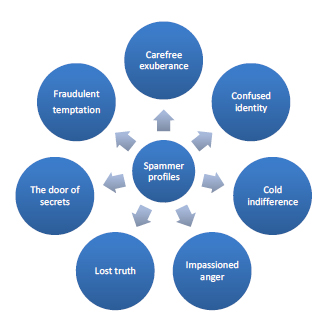7The Deadly Sins of Electronic Mail

Figure 7.1. Spammer profiles
7.1. Carefree exuberance
There are users who guilelessly contribute to multiplying superfluous e-mails, which results in overflowing inboxes and incensed recipients. It happens, first of all, through broadcast of the type generated by an overzealous employee who sends e-mails to more recipients than needed, often multiplying messages by wrongly using “Cc:” or indiscriminately hitting reply to all. And what should be said about those e-mails that just say thank you (a simple “Thank you!” that is so polite, and annoying at the same time)?
Then, some colleagues are in such a hurry that they click and rush, they burst in your office or call within seconds after they hit the Send button, in an attempt to ask you to reply at the message they have just sent in. Thus, their physical intrusion in your work space and time adds to the electronic, but no less real, interruption generated by the incoming message alert.
And there are also colleagues who cause their own problems when, falling prey to fleeing enthusiasm, they subscribe during the years to too many mailing lists, online forums, and e-mail notifications, which generate a difficult to manage mass of messages – bacn – that invade their inbox. Or those who, in a similar manner, tend to abuse broadcast and expose themselves to a tidal wave of replies: too many messages ...
Get E-mail and Behavioral Changes now with the O’Reilly learning platform.
O’Reilly members experience books, live events, courses curated by job role, and more from O’Reilly and nearly 200 top publishers.

